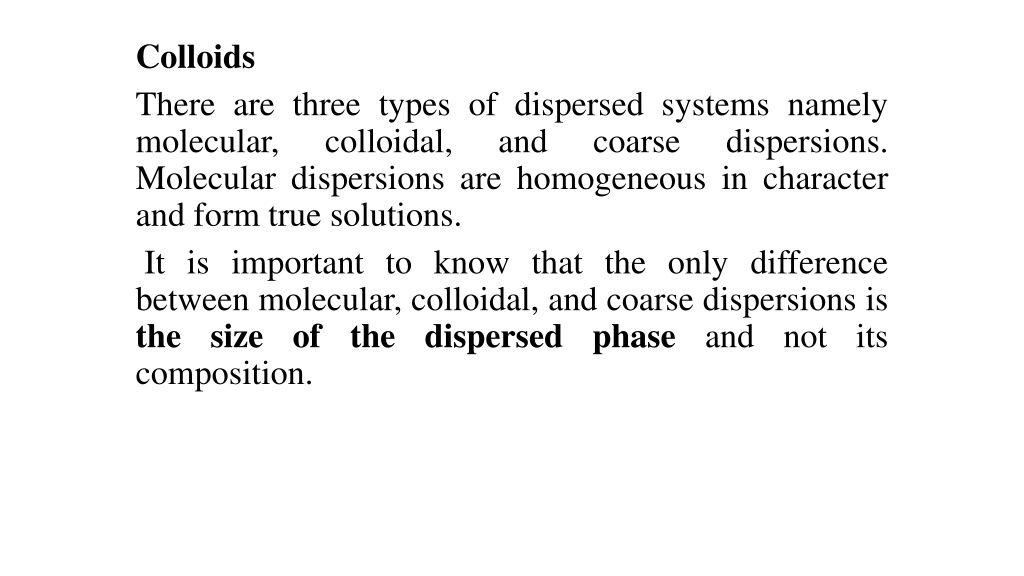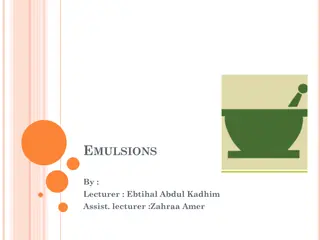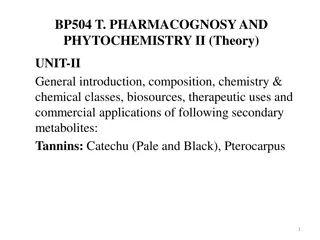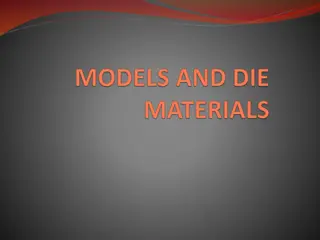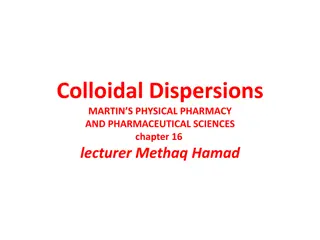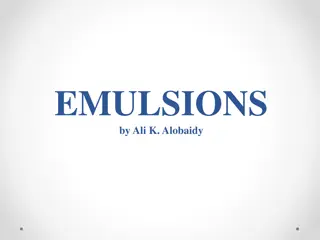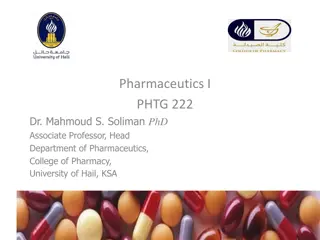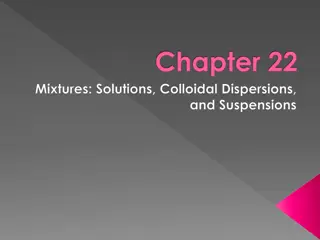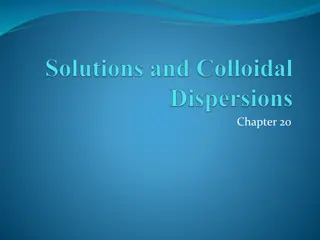Understanding Colloidal Dispersions and Classification
In the realm of dispersed systems, molecular, colloidal, and coarse dispersions differ in size rather than composition. Colloidal dispersions consist of particles ranging from 1 nm to 1 micrometer, exhibiting unique characteristics and examples. The classification is also based on physical states and interactions between dispersed phases and dispersion mediums. Solid-in-liquid dispersions are categorized as lyophilic, lyophobic, or association colloids based on their affinity. This comprehensive guide sheds light on the distinctions and characteristics of colloids for better comprehension.
Download Presentation

Please find below an Image/Link to download the presentation.
The content on the website is provided AS IS for your information and personal use only. It may not be sold, licensed, or shared on other websites without obtaining consent from the author. Download presentation by click this link. If you encounter any issues during the download, it is possible that the publisher has removed the file from their server.
E N D
Presentation Transcript
Colloids There are three types of dispersed systems namely molecular, colloidal, and Molecular dispersions are homogeneous in character and form true solutions. It is important to know that the only difference between molecular, colloidal, and coarse dispersions is the size of the dispersed phase and not its composition. coarse dispersions.
Colloidal containing particles in the size range of between approximately 1 nm and 1 micrometer, however a smaller size range of up to 500 nm is also quoted. dispersions can be characterized as
Class Molecular dispersion Particle size Less than 1 nm Characteristic of system Invisible in electron microscope Pass through ultrafilter (0.01 micron) and semipermeable membrane Undergo rapid diffusion Not resolved (to determine) by ordinary microscope (although may be detected under ultramicroscope,) Visible in electron microscope, Pass through filter paper, Do not pass semipermeable membrane, Diffuse very slowly Example Oxygen molecules, ordinary ions, glucose Colloidal dispersion From 1 nm to 0.5 m Colloidal silver sols, natural and synthetic polymers, cheese, butter, jelly, paint, milk, shaving cream, etc.
Class Particle size Characteristic of system Example Coarse dispersion Greater than 0.5 m Visible under microscope; Do not pass through normal filter paper; Do not dialyze through semipermeable membrane; Do not diffuse Grains of sand, most pharmaceutical emulsions and suspensions, red blood cells
Classification Based on physical states of dispersed and continuous phases
Classification based on interaction between dispersed phases and dispersion mediums This classification is based on the affinity or interaction between the dispersed phase and the dispersion medium. This classification refers mostly to solid-in-liquid dispersions. Colloidal dispersions are divided into the two broad categories, lyophilic and lyophobic. Some soluble, low-molecular-weight molecules with both tendencies and associate in solution, forming a third category called association colloids. substances have
Lyophilic dispersions The system is said to be lyophilic (solvent-loving) if there is considerable attraction between the dispersed phase and the liquid vehicle (i.e., extensive solvation). The system is said to be hydrophilic if the dispersion medium is water. Due to the presence of high concentrations of hydrophilic groups, solids such as bentonite, starch, gelatin, acacia, and povidone swell, disperse, or dissolve spontaneously in water to the greatest degree possible without breaking covalent bonds.
Hydrophilic colloids often contain ionized groups that dissociate into highly hydrated ions (e.g., carboxylate, sulfonate, and alkylammonium functional groups that bind water through hydrogen bonding (e.g., hydroxyl, carbonyl, amino, and imino groups). organic ions) and/or
Hydrophilic colloidal dispersions can be further subdivided as: True solutions: Water-soluble polymers (e.g., acacia and povidone) Gelled solutions: Gels, or jellies: polymers present at sufficiently high concentrations and/or at temperatures where their water solubility is low, such as relatively concentrated solutions of gelatin and starch (which set to gels upon cooling) and methylcellulose (which gels upon heating)
Particulate dispersions: Solids that do not form molecular solutions but remain as discrete though minute particles microcrystalline cellulose). (e.g., bentonite and
Lipophilic or oleophilic substances have a strong affinity for oils i.e., mineral oil, benzene, carbon tetrachloride, vegetable oils (e.g., cottonseed or peanut oil), and essential oils (e.g., lemon or peppermint oil). Oleophilic colloidal dispersions include polymers such as polystyrene and gum rubber magnesium, or aluminum stearate dissolved or dispersed in cottonseed oil, and activated charcoal, which forms sols or particulate dispersions in all oils. dissolved in benzene,
Lyophobic dispersions The dispersion is said to be lyophobic (solvent-hating) when there is little attraction between the dispersed phase and the dispersion medium. Hydrophobic dispersions consist of particles that are only hydrated slightly or not at all, because water molecules prefer to interact with one another instead of solvating the particles. Therefore, such particles do not disperse or dissolve spontaneously in water.
Examples of materials that form hydrophobic dispersions include organic compounds hydrocarbon portions with few, if any, hydrophilic functional groups (e.g., cholesterol and other steroids); some nonionized inorganic substances (e.g., sulfur); and oleophilic materials such as polystyrene or gum rubber, organic lipophilic drugs, paraffin wax, magnesium stearate, and cottonseed or soybean oils. consisting largely of
Materials such as sulfur, silver chloride, and gold form hydrophobic dispersions without being lipophilic. There is no sharp dividing line between hydrophilic and hydrophobic dispersions. For example, gelatinous hydroxides of polyvalent metals (e.g., hydroxide) and clays (e.g., bentonite and kaolin) possess some characteristics of both. Common lipophobic dispersions include water-in-oil (W/O) emulsions, which are essentially lyophobic dispersions in lipophilic vehicles. aluminum and magnesium
Association colloids Organic compounds that contain large hydrophobic moieties on the same molecule with strongly hydrophilic groups are said to be amphiphilic. The individual molecules are generally too small to be in the colloidal size range, but they tend to associate into larger aggregates when dissolved in water or oil. These compounds are designated association colloids, because their aggregates are large enough to qualify as colloidal particles. Examples include surfactant molecules that associate into micelles above their critical micelle concentration (CMC).
These aggregates, which may contain 50 or more monomers, are called micelles. Because the diameter of each micelle is of the order of 50 , micelles lie within the size range we have designated as colloidal. The concentration of monomer at which micelles form is termed the critical micelle concentration(CMC). The number of monomers that aggregate to form a micelle is known as the aggregation number of the micelle.
The phenomenon of micelle formation can be explained as follows. Below the CMC, the concentration of amphiphile undergoing adsorption at the air water interface increases as the total concentration of amphiphile is raised. Eventually, a point is reached at which both the interface and the bulk phase become saturated with monomers. This is the CMC. Any further amphiphile added in excess of this concentration aggregates to form micelles in the bulk phase.
In the case of amphiphiles in water, the hydrocarbon chains face inward into the micelle to form, in effect, their own hydrocarbon environment. Surrounding this hydrocarbon core are the polar portions of the amphiphiles associated with the water molecules of the continuous phase. Aggregation also occurs in nonpolar liquids. The orientation of the molecules is now reversed, however, with the polar heads facing inward while the hydrocarbon chains are associated with the continuous nonpolar phase.
Lyophilic Association (Amphiphilic) Lyophobic Dispersed phase consists generally of large organic molecules lying within colloidal size range Dispersed phase consists of aggregates (micelles) of small organic molecules or ions whose size individually is below the colloidal range Dispersed phase ordinarily consists of inorganic particles, such as gold or silver
Lyophilic Association (Amphiphilic) Hydrophilic or lipophilic portion of the molecule is solvated, depending on whether the dispersion medium is aqueous or nonaqueous Lyophobic Molecules of dispersed phase are solvated, i.e., they are associated with the molecules comprising the dispersion medium Little if any interaction (solvation) occurs between particles and dispersion medium Molecules disperse spontaneously to form colloidal solution Colloidal aggregates are formed spontaneously when the concentration of amphiphile exceeds the critical micelle concentration Material does not disperse spontaneously, and special procedures therefore must be adopted to produce colloidal dispersion
Lyophilic Association (Amphiphilic) Viscosity of the system increases as the concentration of the amphiphile increases, as micelles increase in number and become asymmetric Lyophobic Viscosity of the dispersion medium ordinarily is increased greatly by the presence of the dispersed phase; at sufficiently high concentrations, the sol may become a gel; viscosity and gel formation are related to solvation effects and to the shape of the molecules, which are usually highly asymmetric Viscosity of the dispersion medium is not greatly increased by the presence of lyophobic colloidal particles, which tend to be unsolvated and symmetric
Lyophilic Association (Amphiphilic) In aqueous solutions, the critical micelle concentration is reduced by the addition of electrolytes; salting out may occur at higher salt concentrations Lyophobic Dispersions are stable generally in the presence of electrolytes; they may be salted out by high concentrations of very soluble electrolytes; effect is due primarily to desolvation of lyophilic molecules Lyophobic dispersions are unstable in the presence of even small concentrations of electrolytes; effect is due to neutralization of the charge on the particles; lyophilic colloids exert a protective effect
Preparation of colloids To prepare a colloidal dispersion it is necessary to disperse the solid in particles of the correct colloidal size, which can be done by 1. Breaking down the bulk material (Dispersion method) 2. By building up the particles from single molecules (Condensation method). subcolloidal dimensions are caused to aggregate into particles within the colloidal size range In which materials of
Dispersion method Mechanical dispersion A coarse suspension of a substance is prepared in the dispersion medium and passed through a colloidal mill. The two discs of the colloidal mill rotate at a high speed in opposite directions. The suspension is exposed to a powerful shearing force and the course particle are reduced in size to yield particles of colloidal dimension. Dispersion can also be achieved by the use of high-intensity ultrasonic generators operating at frequencies in excess of 20,000 cycles per second
Electro-dispersion A second dispersion method involves the production of an electric arc within a liquid. Owing to the intense heat generated by the arc, some of the metal of the electrodes is dispersed as vapor, which condenses to form colloidal particles
Peptization It is a second dispersion method used to prepare colloidal dispersions. The term is defined as the breaking up of aggregates (or secondary particles) into smaller aggregates (or primary particles) that are within the colloidal size range. Peptization is synonymous with deflocculation. It can be brought about by the removal of flocculating agents, usually electrolytes, or by the addition of deflocculating or peptizing agents, usually surfactants.
When powdered activated charcoal is added to water with stirring, the aggregated grains cannot be completely broken up and the resulting suspension is gray and translucent. The addition of 0.1 percent sodium lauryl sulfate or octoxynol deflocculates the grains into finely dispersed particles and results in a deep-black and opaque dispersion.
Ferric or aluminum hydroxide that has been freshly precipitated with ammonia can be peptized with small amounts of acids that reduce the pH below the isoelectric points of the hydroxides. Even washing the gelatinous precipitate of Al(OH)3 with water tends to peptize it.
Condensation methods Physical method Change of solvent Sulfur is insoluble in water but somewhat soluble in alcohol. When an alcoholic solution of sulfur is mixed with water, a bluish white colloidal dispersion results. This technique of first dissolving a material in a water-miscible solvent such as alcohol or acetone and then producing a hydrosol by precipitation with water is applicable to many organic compounds.
Another less common physical condensation method is to introduce a current of sulfur vapor into water, which produces colloidal particles.
Change of pH Weak bases, such as the alkaloids, are usually much more soluble at lower pH values while at higher pH values they exist as the free base. Therefore, increasing the pH of their aqueous solutions above their pKa may cause precipitation of the free base. Conversely, organic compounds that are weak acids, such as the barbiturates, are usually much more soluble at higher pH values and exist as the free acid form at low pH. Therefore, lowering the pH of their aqueous solutions well below their pKa usually causes precipitation of the free acid.
Chemical methods Hydrolysis Sols of ferric, aluminum, chromic, stannic, and titanium hydroxides or hydrous oxides are produced by the hydrolysis of the corresponding chlorides or nitrates.
Oxidation If a solution of hydrogen sulphide and Sulphur dioxide are mixed.ASulphur sol is produced
Reduction A violet colloidal solution of gold can be obtained by the reduction of gold chloride solution using stannous chloride as reducing agent 2AuCl3+3 SnCl2 3 SnCl4+2Au In addition, the reduction of gold, silver, copper, mercury, platinum, rhodium, and palladium salts hydroxylamine, hydroquinone, or stannous chloride forms hydrosols of the metals, which are strongly colored (e.g., red or blue). with formaldehyde, hydrazine,
Double decompositions This reaction produce insoluble salts of colloidal dimension. An example is silver chloride NaCl +AgNO3 AgCl + NaNO3
Properties of colloids Optical Properties of Colloids The Faraday Tyndall Effect When a strong beam of light is passed through a colloidal sol, a visible cone, resulting from the scattering of light by the colloidal particles, is formed. This is the Faraday Tyndall effect.
The light-scattering effect is made use of in the design of the ultramicroscope. An intense light beam is passed through the sol against a dark background at right angles to the plane of observation, and, although the particles cannot be seen directly, the bright spots corresponding to particles can be observed and counted.
Light scattering This property depends on the Faraday Tyndall effect and is widely used for determining the molecular weight of colloids. When clear mineral oil is dispersed in an equal volume of a clear, aqueous surfactant solution, the resultant emulsion is milky white and opaque as a result of light scattering. However, microemulsions containing emulsified droplets that are only about 40 nm in diameter (i.e., much smaller than the wavelength of visible light) are transparent and clear to the naked eye.
The dispersions and of bacterial suspensions can be measured by their Tyndall effect or turbidity. Where I0and Itare the intensities of the incident and transmitted light beams, and l is the length of the dispersion through which the light passes. The concentration of dispersed particles can be measured by measuring the intensity of the light transmitted in the incident direction. concentration of inorganic and organic colloidal
Kinetic properties of colloids Kinetic properties of colloidal systems that relate to the motion of particles with respect to the dispersion medium. Brownian motion It describes the random movement of colloidal particles. The erratic motion, which may be observed with particles as large as about 5 m, was explained as resulting from the bombardment of the particles by the molecules of the dispersion medium.
The motion of the molecules cannot be observed, of course, because the molecules are too small to see. The velocity of the particles increases with decreasing particle size. Increasing the viscosity of the medium, which may be accomplished by the addition of glycerin or a similar agent, decreases and finally stops the Brownian movement.
Diffusion Colloidal particles diffuse spontaneously from a region of higher concentration to one of lower concentration until the concentration of the system is uniform throughout. Diffusion is a direct result of Brownian movement. Radius of the colloidal particles can be obtained from its diffusion.
where D is the diffusion coefficient (the amount of material diffusing per unit time across a unit area), R is the molar gas constant, T is the absolute temperature, is the viscosity of the solvent, r is the radius of the spherical particle, and N is Avogadro's number
The measured diffusion coefficient can be used to obtain the molecular weight of approximately spherical molecules. where M is molecular weight and [v with bar above] is the partial specific volume (approximately equal to the volume in Cm3of 1 g of the solute, as obtained from density measurements
Osmotic Pressure The pressure that would have to be applied to a pure solvent to prevent it from passing into a given solution by osmosis, often used to express the concentration of the solution. The osmotic pressure, , of a dilute colloidal solution is described by the van't Hoff equation: = cRT where c is molar concentration of solute. This equation can be used to calculate the molecular weight of a colloid in a dilute solution. Replacing c with cg/M in above equation, in which cg is the grams of solute per liter of solution (mole) and M is the molecular weight, we obtain.
Sedimentation The velocity, v, of sedimentation of spherical particles having a density in a medium of density 0 and a viscosity 0 is given by Stokes's law: where g is the acceleration due to gravity. If the particles are subjected only to the force of gravity, then the lower size limit of particles obeying Stokes's equation is about 0.5 m. This is because Brownian movement becomes significant and tends to offset sedimentation due to gravity and promotes mixing instead.
Consequently, a stronger force must be applied to bring about the sedimentation of colloidal particles in a quantitative and measurable manner. This is accomplished by use of the ultracentrifuge, developed by Svedberg in 1925, which can produce a force one million times that of gravity.
Viscosity Viscosity is an expression of the resistance to flow of a system under an applied stress. The more viscous a liquid is, the greater is the applied force required to make it flow at a particular rate. The viscosity of dilute colloidal dispersions of spherical particles is determined by
